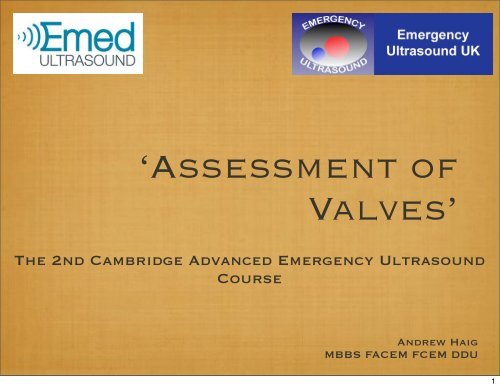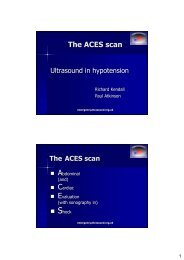'Assessment of Valves' - Emergency Ultrasound
'Assessment of Valves' - Emergency Ultrasound
'Assessment of Valves' - Emergency Ultrasound
You also want an ePaper? Increase the reach of your titles
YUMPU automatically turns print PDFs into web optimized ePapers that Google loves.
Aortic Valve4
Aortic ValveComposed <strong>of</strong> 3 cusps <strong>of</strong> equal sizeWhen viewed from a conventional TTE short-axisprojection the closure lines <strong>of</strong> the 3 cusps forms a ‘Y’shapebehind each cusp there is a sinus <strong>of</strong> valsalva.The left and right coronary arteries arise from theleft and right sinuses respectively, and are associatedwith the left and right cuspsNormal aortic valve area: 2.5 - 3.5 cm 2 5
Aortic StenosisNormal area <strong>of</strong> the aortic valve is > 2cm 2Significant narrowing restricts LV outflow imposing apressure load on the LVLeads to Hypertrophy <strong>of</strong> the LVSymptoms: Exertional anginaDyspnoeaExertional syncope6
Aortic StenosisAS may occur at 3 Levels - ValvularValvular ASSubvalvularSupravalvularRheumatic Heart Disease: Usually associated with mitral valvediseaseCalcific (degenerative) ASCongenital Bicuspid Valve (1-2% <strong>of</strong> the population)7
Aortic valveRCCNCCRCCLCCNCC9
Aortic StenosisMobilityIs it normal or reduced?Is there systolic bowing? (Bicuspid, Rheumatic)Is there diastolic prolapse (Floppy valve, tear, bicuspid)10
Aortic Stenosis13
Aortic StenosisSevere Aortic Stenosis14
Aortic StenosisMild Aortic Stenosis15
Severe Aortic Stenosis16
Assessment <strong>of</strong> the LV inAortic StenosisLook for hypertrophy <strong>of</strong> the LV which suggests(but Does not Prove) severe stenosis(IVS / Posterior wall >11mm in Diastole)If the LV function is impaired, the transaorticpressure difference may underestimate theseverity <strong>of</strong> the stenosis17
Aortic StenosisAortic Stenosis with Severe LV Dysfunction18
Aortic StenosisQuantification <strong>of</strong> AS severity usingContinuous wave Spectral DopplerMeasure Maximum aortic jet velocityCalculate maximum and mean transaorticpressure gradientscalculate the effective orifice area19
Trans-Aortic Jet VelocityMeasure the continuous waveform <strong>of</strong> theaortic jet from the apexNormal trans-aortic jet velocity is 1.0 - 1.7 m/sAortic Vmax: Mild Stenosis: 2.0 - 3.0m/sModerate Stenosis: 3.0 - 4.5m/sSevere Stenosis: > 4.5m/s20
Trans-Aortic Jet Velocity21
Peak & Mean Aortic valvePressure GradientsThe peak & mean pressure gradients across theaortic valve can be calculated from themaximal aortic jet velocity using theBernoulli Equation22
Peak & Mean Aortic valvePressure GradientsNB:If there is co-existent LV systolic dysfunctionthere may be a decreased trans-aortic pressuregradient and so the severity <strong>of</strong> the AorticStenosis will be underestimatedIf there is coexistent aortic regurgitationthere will be increased trans-aortic volumeflow which will increase the trans-aorticpressure gradient and therefore moderate tosevere AR may overestimate the severity <strong>of</strong>the Aortic Stenosis23
Severity in aortic stenosis______________________________________________________Mild Moderate Severe____________________________________________________________________________Aortic Vmax (m/s) 2.0 - 3.0 3.0 - 4.5 >4.5Peak Gradient (mmHg) < 40 40 - 80 > 80Mean Gradient (mmHg) < 20 20 - 50 > 50EOA (continuity eqn) >1.0 0.6 - 1.0 < 0.6(cm 2 )24
Aortic Stenosis: SummaryValve anatomy: Aetiology <strong>of</strong> stenosisExclude other causes <strong>of</strong> left ventricularoutflow obstructionStenosis severity: Jet velocityMaximum & Mean Pressure GradientEffective valve areaDegree <strong>of</strong> co-existent aortic regurgitationLeft ventricular hypertrophy & systolicfunction25
Mitral Valve26
Mitral ValveAnatomyMitral valve apparatus includes the mitral annulus,the leaflets, chordae tendineae papillary muscles andthe underlying ventricular wallThere are 2 mitral valve leaflets; anterior andposterior, the anterior being the larger.Each leaflet is divided into 3 scallopschordae attached throughout the entire length <strong>of</strong> thecoaptation line and insert into the tips <strong>of</strong> thepapillary apparatus27
Mitral Valve2 major papillary musclesAnterolateral Papillary Muscle:chordae to anterolateral half <strong>of</strong> both mitral valvesDual blood supplyPosteromedial Papillary Muscle:Chordae to posteromedial half <strong>of</strong> both mitral valvesPerfused by RCAZona Coapta: Coaptation <strong>of</strong> the mitral valve iscomplex and involves overlap <strong>of</strong> the mitral valvetissueNormal Mitral Valve area: 4-6cm 2 28
Parasternal Long-Axis29
Parasternal Short-Axis30
Apical 4-Chamber31
Mitral RegurgitationAetiologyIschaemic:restricted posterior leafletprolapsepapillary muscle rupture or dysfunctionFunctionalFloppy Mitral ValveRheumaticEndocarditisOther ie SLE32
Mitral RegurgitationFeatures <strong>of</strong> MRAcute vs ChronicLV volume overload with dilatationLA dilatation33
Assessment <strong>of</strong> Mitral RegurgitationAppearance & Movement <strong>of</strong> the valve leafletsColour flow mappingContinuous wave DopplerLeft Ventricular FunctionPulmonary Artery Pressure34
Appearance & MovementWhat is the distribution and degree <strong>of</strong> any leafletthickening?Is there a discrete echogenic mass (e.g. vegetation)?Does the valve open normally during diastole or isthere bowing to suggest <strong>of</strong> the leaflets to suggestrheumatic disease?Is there evidence <strong>of</strong> leaflet prolapseIs there restriction <strong>of</strong> the posterior leaflet duringsystole?35
estricted posterior mitral valve leaflet36
Posteriorly directed MR jet due to restriction <strong>of</strong> theposterior mitral valve leaflet37
MR in a patient with dilated cardiomyopathy and apicaldisplacement <strong>of</strong> the papillary muscles leading to functionalmitral regurgitation38
severe functional mr associated with apical displacement<strong>of</strong> the papillary Muscles39
Colour Flow MappingColour Doppler imaging is the primaryechocardiographic tool for the detection andquantitation <strong>of</strong> Mitral regurgitationAssess the width <strong>of</strong> the base <strong>of</strong> the jet at thelevel <strong>of</strong> the valveAssess the jet area40
Mitral Regurgitationreproduced from: Echocardiography a practical guide for reporting42
Continuous Wave DopplerAssess the density <strong>of</strong> the Continuous WaveDoppler signalThe intensity <strong>of</strong> the jet is greater with moresevere mitral regurgitation43
Mild RegurgitationModerate RegurgitationSevere Regurgitation44
Left Ventricular FunctionBy definition, haemodynamically significantmitral regurgitation results in volumeoverload <strong>of</strong> the left ventricle withsubsequent LV & LA dilatationThe increased LA pressure will lead topulmonary congestion45
Mitral RegurgitationIndicators <strong>of</strong> degree <strong>of</strong> mitral regurgitationMildSevereJet width at base (cm) 1Jet area (cm 2 ) 8.0Density on CW Doppler + ++46
Mitral Regurgitation: SummaryValve anatomy and movement: Aetiology <strong>of</strong>regurgitationAssess severity using colour flow mapping &continuous wave DopplerAssess for LV dilatation and systolicdysfunctionAssess for other valve disease47





